Sensors. The low-end stuff that we can get our hands on usually suffers from poor range, lack of sensitivity, and no way to characterize what the target is. But today we can use the good stuff that, until recently, was only available to military: radar. In this post we will discuss how radar works, commercially available small radar devices, and where to learn more to help make it easy to add radar to your next project. Reach out and sense something!
Radar Basics
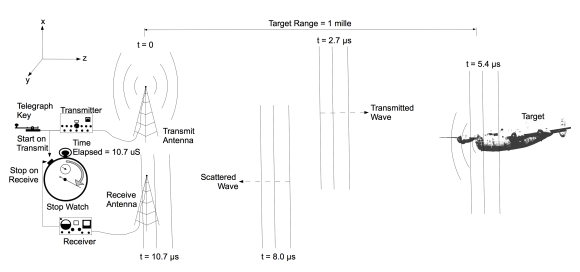
Radar is simple, it consists of a radio transmitter and receiver. Radar is a World War Two acronym meaning Radio Direction and Ranging, in other words a radar consists of a radio transmitter and receiver where the range to an object is measured by clocking the time between the transmitter transmitting a known modulated waveform and the receiver receiving this waveform scattered from a target.
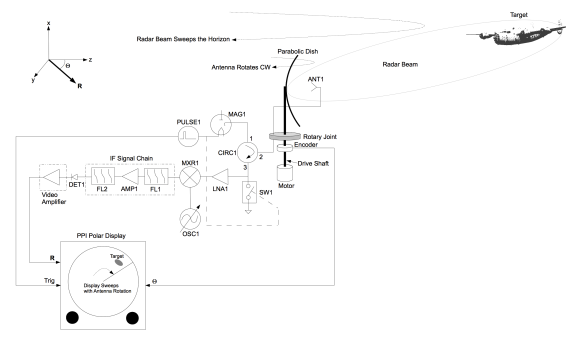
One enabling technology for Radar was the cathode ray tube (CRT), which facilitated a method of measuring the time delay between transmitted and received waveforms. This led to the development of numerous radar sensors used in the second world war, which generally followed the Plan Position Indicator (PPI) architecture.
Toady, rather than using a CRT we can use high-speed digitizers. This offers the obvious advantage of applying signal processing to acquired data so that only moving targets are detected, tracking can be achieved, imaging, and a multitude of other modes.
But for hobbyist and consumer projects we do not need this much power, range, and can not afford the cost. We need the ability to sense like a long range radar (detecting only moving targets, imaging, Doppler, signatures, etc) but at short ranges and at low costs.
Very few off-shelf small radar options exist as of today. In this post we’ll review these, their basic architectures, and direct you on the next steps.
Continuous Wave (CW) Doppler Radar
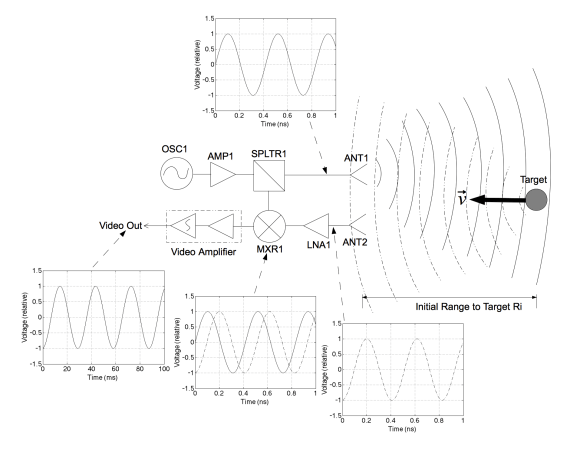
If you are not interested in ranging or imaging but would like to measure velocities or radar signatures then consider CW Doppler radar. CW Doppler radar works by feeding the output of a CW oscillator to an antenna and radiates that carrier towards a moving target. This carrier scatters off the moving target back to the receive antenna where it is amplified and fed to a frequency mixer. The mixer mixes the oscillator and the scattered carrier resulting in a Doppler shift product. This product is the Doppler shift off of the carrier’s center frequency and is generally in the KHz range. Low enough to be easily digitized by the audio input port of a laptop computer or other low-cost digitizer.
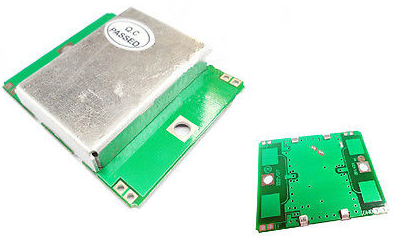
Try a CW Doppler radar. You can hack an old police radar gun by locating the video amplifier or mixer’s output and plugging that signal into the audio input port of your laptop and displaying this data using a ‘water fall’ Fourier transform.
If you find an old motion sensor or door opener. These typically use CW Doppler radar modules known as Gunnplexers. Hack into one just as you would with the Police radar.
Or, you can procure new off-shelf X-band CW Doppler radar devices from China for < $10 on Ebay. I’ve used these devices before, they do work but have limited range. This may not matter for your project.
Impulse Radar
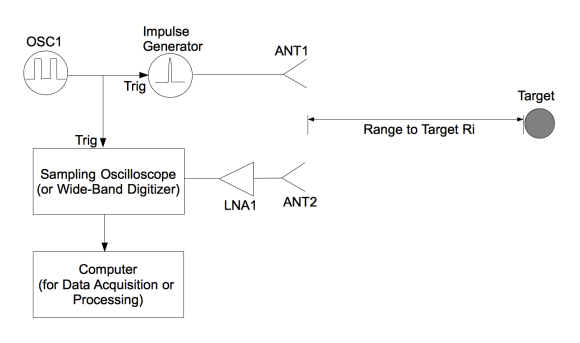
Short range radars sense at 150m or less. At these short ranges extremely short pulses (meaning short in time duration, nS or pS in duration) are required to provide sufficient resolution to be useful. Short pulse, or impulse radar systems, generally follow a simple architecture where the impulse generator is often tied directly to a transmit antenna and a low noise amplifier (LNA) is tied to a receive antenna. A high speed digitizer is triggered off the impulse generator and acquires data on the output of the LNA.

You can incorporate impulse radar technology into your next project. Commercial versions of impulse radars are available to hobbyists and developers. Most notable are the ASIC based impulse radar manufactured by Novelda. These devices do require external antennas but contain on-board radar and high speed digitizers.
Additional impulse radar systems are being manufactured in quantity for automotive applications (blind spot detection, parking aids, etc), but details on these are not easy to find unless you directly engage the manufacturers. Manufacturers of automotive radar equipment include, Delphi, Continental, TRW, Bosch, Denso, and Autoliv.
Frequency Modulated Continuous Wave (FMCW) Radar
FMCW radar was originally used in radar altimeters starting in the 1930’s. Today, FMCW radar is the leading short-range radar architecture because it offers short-pulse radar resolution while providing significantly greater sensitivity with the same peak transmit power. This is because FMCW radars transmit continuously and leverage the discrete Fourier transform (DFT) to increase SNR in proportion to the time over which the DFT is applied. But for a hobbyist the key take-away is that these radars use a simple architecture and radar signals can be acquired by low-bandwidth digitizers such as the audio input port on your laptop, ADC input ports on micro controllers, the lower cost National Instruments NIDAQ units, etc.
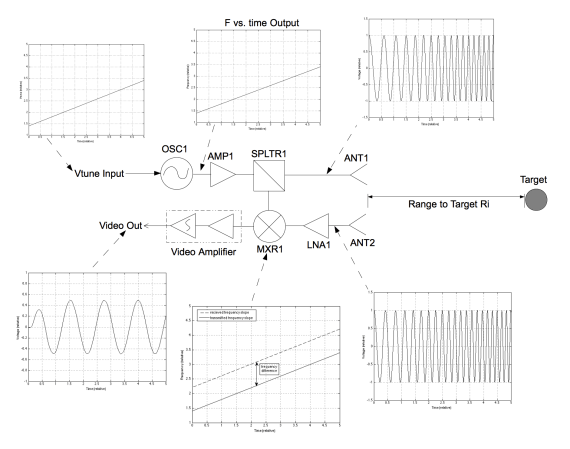
For an FMCW radar, a CW oscillator is frequency modulated with a linear ramp. In other words, the CW oscillator starts at one frequency and ramps-up to a second over a relatively long period of time (0.5-10 uS). This waveform is radiated out of the transmit antenna towards the target scene. Some of this waveform is fed to the receiver mixer. What is scattered off the target is amplified by the LNA and fed into the receive mixer where it is mixed with the transmit waveform. The mixing product results in a low frequency (KHz range) beat tone that is proportional to range. The higher the frequency of beat tone the further the target. If measuring a multitude of targets then expect to see a multitude of beat tones superimposed on each other. To measure the range to targets you digitize with a low bandwidth digitizer being careful to synchronize the digitizer’s trigger with the start of the up-ramp. With this digitized data for each up-ramp, apply the DFT. This results in a time domain representation of the round trip time from transmitter, to targets, and back to receiver.
Add an FMCW radar to your next project. FMCW radar devices are available for developers and hobbyists. Some of the lowest cost FMCW radar devices are manufactured by RF Beam Microwave GmbH, who offers 24 GHz FMCW radar modules for less than $10 in quantity, shown here is a K-LC1.
In addition to this, you can build your own ‘Coffee Can Radar’ from the MIT Opencourseware site.
Not interested in building your own coffee can radar from scratch? You can buy a ready-made coffee can radar kit form Quonset Microwave. This radar provides data via a USB or BlueTooth.
And coming soon will be the radar Arduino shield! Credit for this belongs to Tony Long, who developed this shield loosely based on the MIT Coffee Can radar.
Learn more
Add a radar sensor to your next project. It is not difficult to do with some basic understanding of architectures and signal processing. To learn more,
- teach yourself for free with the MIT OCW course,
- Pick up Gregory Charvat’s book: Small and Short-Range Radar Systems (use promo code EEE24 for discount),
- If you need help please visit the community forum which Greg set up.
- Want to learn fast and your employer is willing to pay for a short-course? Sign up to the MIT Professional Education Short-Course ‘Build a Small Radar System,’ and learn about small radar systems by making your own in 5 days. This was the top-ranked MIT Professional Ed course in 2011.
We can do this.
Soon small radar devices will be everywhere, let your project be one of the first!
 Gregory L. Charvat, is author of Small and Short-Range Radar systems, co-founder of Butterfly Network Inc., visiting research scientist at the Camera Culture Group MIT Media Lab, and editor of the Gregory L. Charvat Series on Practical Approaches to Electrical Engineering. He was a technical staff member at MIT Lincoln Laboratory from September 2007 to November 2011, where his work on through-wall radar won best paper at the 2010 MSS Tri-Services Radar Symposium and is an MIT Office of the Provost 2011 research highlight. He has taught short radar courses at the Massachusetts Institute of Technology, where his Build a Small Radar Sensor course was the top-ranked MIT professional education course in 2011 and has become widely adopted by other universities, laboratories, and private organizations. He has developed numerous rail SAR imaging sensors, phased array radar systems, and impulse radar systems; holds several patents; and has developed many other radar sensors and radio and audio equipment. He earned a Ph.D in electrical engineering in 2007, MSEE in 2003, and BSEE in 2002 from Michigan State University, and is a senior member of the IEEE, where he served on the steering committee for the 2010 and 2013 IEEE International Symposium on Phased Array Systems and Technology and chaired the IEEE Antennas and Propagation Society Boston Chapter from 2010-2011.
Gregory L. Charvat, is author of Small and Short-Range Radar systems, co-founder of Butterfly Network Inc., visiting research scientist at the Camera Culture Group MIT Media Lab, and editor of the Gregory L. Charvat Series on Practical Approaches to Electrical Engineering. He was a technical staff member at MIT Lincoln Laboratory from September 2007 to November 2011, where his work on through-wall radar won best paper at the 2010 MSS Tri-Services Radar Symposium and is an MIT Office of the Provost 2011 research highlight. He has taught short radar courses at the Massachusetts Institute of Technology, where his Build a Small Radar Sensor course was the top-ranked MIT professional education course in 2011 and has become widely adopted by other universities, laboratories, and private organizations. He has developed numerous rail SAR imaging sensors, phased array radar systems, and impulse radar systems; holds several patents; and has developed many other radar sensors and radio and audio equipment. He earned a Ph.D in electrical engineering in 2007, MSEE in 2003, and BSEE in 2002 from Michigan State University, and is a senior member of the IEEE, where he served on the steering committee for the 2010 and 2013 IEEE International Symposium on Phased Array Systems and Technology and chaired the IEEE Antennas and Propagation Society Boston Chapter from 2010-2011.




















Wow – what a great, in-depth post! Thanks!
This is the best post I’ve seen on hackaday for months. Excellent. Thank you.
I’ve been reading up on this ever since the original posts about the Coffee Can radar class were making rounds online. I’ve been searching for a way to reduce costs, so the low cost modules mentioned here are a goldmine for me. I’ve also been researching digitally steerable planar arrays for short range applications, but GHz capable programmable delay lines are definitely not in my budget, and I’m not a chip designer. This summary has been helpful in summarizing what I’ve seen and stuff I’ve missed.
As for hardware… wow, lots going on in Europe I see. Not finding any RF Beam distributors here in the US, so we might need to do a group buy to get that module at a reasonable price. I’d prefer the Novelda ASIC, but my skills and pocketbook probably can’t support 8GHz RF data. Of note, I’ve seen Freescale coming out with an integrated 4 channel RF module, but that’s at 77GHz. Must mount that on a PCB in a waveguide or something.
Maybe some 2m or 70cm beams could be used. There’s a CW portion on the low end of the 2m amateur band.
Part 97 is actually very specific about what constitutes a mode, and CW radar would not qualify as CW (morse code) by those standards.
Part 97.3(c)(1) defines CW as a mode with a designator x1A or x1B (there are a bunch of letters that can be in place of x), J2A, or J2B, and which *must* be International Morse Code either in the form of an OOK single carrier, or a tone modulated single side band signal. All other emission types are are prohibited, so even if you’ve got an A1A emission (just a simple carrier) that is not modulated with morse code, it is prohibited in those segments.
There is a CW only portion on 6 meters and 2 meters, but no such segment exists on 70 centimeters.
Without information carried on the signal, it might qualify as ‘Test’ type emissions under Part 97, which are permitted from 51 MHz and up, but not inside those CW only segments. If it’s categorized as ‘Pulse’ emissions it’s only permitted above 900 MHz
Contrary to popular belief, Part 97 is quite specific about what can and can’t be transmitted in the US in various segments. You should check out 97.3 and 97.305 and dig around for a cheat sheet on what all those emission designations mean.
Maybe we could institute a new ‘digital mode’… : ]
In europe there are almost no mode limits except in some oddball very low frequency bands <400KHz where only CW is allowed (but AFAIK no limitation to sending morse only).
For good radar operation you want high frequencies anyway so the object is big compared to the wavelength (so it reflects more and scatters less). 2m would probably work ok for an airplane or so, but for indoor usage I would go 2.4/5.8GHz ISM or higher
I am not sure where did you find that info about “no mode limits”. It is completely false, most EU countries have fairly strict lists of which modes are allowed in which parts of the spectrum. The modulation types constituting each mode are also enumerated explicitly, so you cannot just “invent” a new one if you want to stay within your license.
There could be a part of the rules on experimental transmissions with limited power and various exceptions, but that is another story (and different from country to country – yay for the jungle of national regulations …)
Awesome post! I’m kind of left wondering about any caveats re: FCC / equivalent regulatory agencies when dealing with projects like this though. I’m pretty sure most of these bands require a license to operate above a certain power level, but I’m not exactly sure on what the limits *are*. Might be worth a writeup of its own.
Hello overridemymind,
I might be able to help you out with that info there. Here’s a link (http://www.arrl.org/band-plan) where you can find the US bandplan for amateur radio operators (operators holding an amateur license issued by the FCC). There are specific restrictions on certain bands as far as power output is concerned, but the legal limit, as it’s referred, to is 1.5kW.
I do not know which band the above project operates on, though there are bands that do not require an FCC license but still have restrictions (like citizens band, i.e. CB).
I am actually curious about the legality of this too. I have checked my papers and
e.g. the mentioned 24GHz band is an amateur radio band, so, in theory, I could operate there using my HAM license. With my CEPT Novice class, I could work with up to 100W power, with the full license up to 1kW – which isn’t likely what you want to do anyway (hint, your kitchen microwave that will fry your cat to a crisp radiates around 800W …)
However, the regulations are fairly strict about what types of modes (modulation) are allowed. My papers show that 24GHz band has “CW, fone, digi” – i.e. telegraphy, voice modes (like AM, FM or SSB) and the various digital modes (e.g. RTTY, PSK31, etc.) Radar *is not* mentioned anywhere, so my hunch is this it wouldn’t be legal. This varies by country, some places are very strict (like mine) and won’t allow anything that is not “in the book”, some countries permit experiments outside the regular legal boundaries – either with a special permit or limited power or both.
However, from a practical point of view, unless you do something really stupid, you probably aren’t very likely to get caught and fined. There is not a lot of terrestrial equipment around operating at those frequencies that you could cause interference to (and thus get the authorities interested in you). Furthermore, we are talking about minuscule powers and completely line-of-sight systems – a wall would completely block a 24GHz signal at those powers.
Basically, unless you jam a police radar gun (e.g. by re-using a gun from eBay) or cause interference to something like an airport radar, radiotelescope or a satellite ground station, you are unlikely to be detected and fined. And any of the above would require a line-of-sight and a really close distance to the “target” to actually cause interference.
Regards,
Jan
I haven’t looked the regs myself, but I wonder if you couldn’t send pulses (otherwise known as a Morse-code “E”.) Call your radar station a “beacon.” Of course, you’d have to send your call sign from time to time, but all of that is easy enough to do with a little microprocessor in charge.
That’s a grey area, I am not an expert on the rules. However, with the modes you get also max. bandwith you can occupy with each type of modulation, so you could have a problem there as well, especially with the radar type using the frequency sweep.
Makes me wonder about more passive methods. Say, you are already transmitting a WIFI signal, and just look for the returns. Or having a well-known and powerful signal source and looking for ghosting.
Like this: “…Researchers at University College London have developed a way to passively use WiFi as a radar system…”
http://hackaday.com/2012/08/11/seeing-through-walls-using-wifi/
Yeah, that’s exactly what I was thinking of. Thanks for finding the link!
At University College London we’ve also demonstrated passive radar with TV and radio broadcast signals to detect aircraft. Use whatever is out there!
Matt Ash, I think your passive radar project is exactly what I am looking for. I have too much clutter around me to do meaningful forward scatter meteor detection. Passive radar is about the best I might achieve. Can you send a link? Thanks!
There is a designation in 24GHz for movement detection (24.05-24.25 GHz) with 100mW EIRP and 100% duty cycle limit. So while the module may not be allowed under your HAM license you may be able to use it as a movement detection/short-range-radar device.
Alternatively, 24GHz is also an short-range-radar band in most parts of the world. The SRR range is from 21.65-26.65GHz but as this is intended for broadband radar (often FMCW) power spectral density limits are low.
Note that in some countries starting 1 july 2013 the rules for short range radar in 24GHz change (new equipment may not be brought on market in some subbands, but may still be used). The subband 24.25-26.65 GHz allows new equiment until 1/jan/2018.
The module probably has CE/FCC/other testing done for 24GHz ISM since that band is commonly used by radars. Police radar also often uses this frequency as it is license excempt.
Disclaimer: I am not responsible for errors in this text. Furthermore these rules differ by country so you should check it with the regulatory agency.
Well, those rules apply only if you buy a “sealed box” that has been certified to be compliant and falls into the “general permit” category (anything compliant with the rules doesn’t require an extra license to operate) or you are a manufacturer of equipment and have your stuff certified. Homebrew kit or even modifications of commercial gear are typically not allowed for these types of licenses.
That’s the same as with the various PMR/CB radios – in order for those to be legal, the manufacturer/importer has to have them certified to be compliant with the rules (modulation, power, must not allow user modification of key parameters, etc.) and you, as the end user, aren’t allowed to tamper with them.
Amateur radio operators are to use the lowest power that will support communication, although we are permitted to use up to 1500 Watts if that’s what it takes, however in the microwave bands power limits are specified in a different manner. In regards to permitted emissions I wouldn’t expect to see “radar” specified as radar. After said ham satisfies himself over that he than can consider if pulse emissions are permitted by Part 97, they are it appears are on 70cm and up. From there said ham needs to discover what modulation. methods are permitted. The preceding probably aren’t the only considerations, but each ham will have to decide their own comfort level. Being mindful of other licensed or government and military operations in the area, along with keeping power levels low. Last I heard the military still uses the 70 cm band for radar along the US coastlines.
Like N0LKK said, there are a lot of loopholes that you’d have to research with pulse modulation being one of the only legal ways you could run anything that sends and receives rapidly. The FCC I don’t think was ever too fond of amateurs trying to make their own radar systems.
Considering that another name for jammer is ‘RADAR’, I can see why. Hehe, there’s a reason that 60Hz/50Hz filtering has to be done in electronics.
Nice post! Fourier Transforms and radio are fond topics of mine.
super impressed! i love these guest posts, hope we get some more of them. also, small radar modules deserve to be in every project!
Mention was made about CW hacking an old police gun radar – another option that I have seen (but not tried) that people have started hacking and playing with is the old Hot Wheels toy speed radar guns; these are actual radar guns (just not very accurate) – not ultrasonic or anything like that. I find them at thrift stores all the time for a few dollars each.
Inre: the Hot Wheels radar gun hack
http://www.edparadis.com/radar/
This writeup should be featured on Hackaday.
I think it was…
I would love to hear about using backscatter MW to do subsurface imaging. Not *quite* radar but maybe with a shutter wheel per Ben Krasnow’s effort:
http://hackaday.com/2012/11/27/diy-tsa-backscatter-body-scanner/
Novelda chips look very interesting. Do they share the datasheets?
I can’t even find information on how to get a dev kit.
Why do companies make getting dev kits so damn hard?
LULz?
NatSec? (National security)
Effort?????
Profit?
Seriously though, sometimes it has to do with legal reasons. It’s actually one of the things that’s starting to threaten obfuscated IP blobs. Are you SURE that the USB firmware that you just licensed doesn’t provide some undocumented debugger interface? Or are you sure that the driver provided by your competitor for their cards doesn’t violate any of your/3rd parties’ patents?
Long before HDCP, there was DES on a chip. You can imagine the export restrictions. Funny bit: NRA totally missed that aspect of computers – Encryption is considered a (defensive) weapon. In other words, a countermeasure to offensive tricks in information warfare. False data and leaked (but time-sensitive, useless the next day) data can be painful if you’re a bank, for example.
Can you scan something behind walls? I’d use that radar to spy on Pope when he’s on the toilet. Such a cute Pope :3
Depends on the wavelengths. IR? ELF could go through the wall, most likely. Problem is that lower frequencies = less resolution. Wavelengths in miles, hehe?
Yes, with enough power it works. Note the very powerful reflection that the wall produces, so you need a receiver with a good dynamic range (or a good filter to kill the reflection of the wall). 2-4GHz penetrate walls well and still offer some resolution.
However, you must consider that the much weaker echo has to penetrate that wall on the way back as well. Your Wifi has a *transmitter* on the other end, not just a passive reflector, so yeah, it “penetrates”. Unless you are planing to radiate huge amounts of power, you aren’t likely to get much here.
If this was an advertorial to help sell Gregs book, then thank you! that would be the first advertisement in a long while that tried to learn me something (other than brand x is uber cool).
Very neat post. Now…can someone tell me where to get a B-24 to use as a target?
:-)
As odd it sounds to desire a B-24, it’s not as odd as wanting to target the Pope while he is sitting on the toilet.
Targetting the Pope on the toilet would be easy, if it weren’t for all those damn trees in the way…
How about targeting the Pope sitting on a toilet inside a B-24?
If I understand correctly, you can also use CW radar to illuminate a vibrating object to see its oscillations. In this case a number of three letter agency’s use devices that ring/vibrate to audio or video input, they then illuminate it with CW and process the signal, it takes less power to create this oscillation on the “bug” side, is easy to isolate with signal processing. The “bug” is not on unless illuminated by a CW signal so just doing a radio sweep won’t usually find them.
It makes me wonder if this project can be used in such a fashion. Also, when I was younger I asked a local police officer how he knew that his radar was accurate, he pulled out a tuning fork, struck it and pointed his radar at it. He then told me that this was the method used to check the radar for proper operation. I also made note of the sub MPH accuracy. IE 48.00mph. Not sure the last time I got a speeding ticket for .01mph over :)
Chirp chirp – wooden plaque spying.
http://www.spybusters.com/Great_Seal_Bug.html
It’s posts like these that make me want to jump out of my comfort zone and try something crazy (in a good way!). What’s that? It’s the sound of my bank account draining thanks to another hacking obsession…;D
RF has been a primary interest of mine since middle school I like this post and would be glad to see more of them. While others may see the links at the end of advertizing I don’t mind them for this and in posts in general.
Greg Charvat was also a guest on Amphour, (audioblog/podcast):
http://www.theamphour.com/the-amp-hour-115-watcher-of-wraithlike-walls/
http://www.theamphour.com/179-greg-charvat-returns-with-a-book-laboratory-literature-laureate/
I’d been successful in not purchasing this book since you launched it a few months ago.
I’ve failed now.
You win this round Dr. Charvat.
Great post Greg! I’m hoping the radar systems being used in the automotive industry will help push down prices in the hobbyist realm.
guest post aka seo link spam
You missed the Time Domain pulsed Ultra Wideband radar at
http://www.timedomain.com/p400-mrm.php
It meets the FCC regulations for unlicensed operation between 3.1 and 5.2GHz, and is available now.
Great to see Greg continuing his knowledge sharing and super radar crusad! Really brilliant gentleman and professor, Sincerely appreciate your continued postings Greg to us hackers, engineers and DIY’s. I took Gregs MIT build your own doppler radar radar course remotely and build a working desktop Wi-fi radar in like 2 weeks. Even with a strong radar engineering support backround specifically in marine radars I learned so much and was astounded how simple, practicle and helpful Dr. Charvat methods of teacching are regardless of being a MIT student or not. Thank you again Greg fot the great knowledge shares! Keep it up! Will definetly buy the arduino radar shield when it becomes available. John Neyland.
Hmm, isn’t there some kind of RADAR where you emit a seemingly random pulse of modulated binary data and then detect it using a demodulator and shift registers? Nothing says that the signal can’t be just any detectible one?
Yes, the signal you use needs good autocorrelation properties though, otherwise you will have ambiguities, for example a pure sine wave is useless. The more random the signal the better.
Howard Stern!!!!
How’s that for randomness!
Well, he is white noise, afterall…
Nice uptick in quality HAD!
I, too, have been an avid follower of H.A.D. for quite some time now, and remember the original post involving the ‘coffee can radar’. And while this is my first comment(Well, second actually, given the first part of this one a moment ago), I certainly don’t plan on it being my last! That being said, I thoroughly enjoyed this post, and am working on a ‘modern, ‘P.O.W.’ style radar’ based on improvisations inspired by the wartime radios, including both simple transmitters and recivers, as well as hualf and full duplex communication devices, that is based on little more than hope, handiness, an imagination, and utilising little more than barbwire, salt, lye, or acid batteries, razor blade or baking soda diodes and maybe a few flame triodes or transformer based amplifiers. Been mulling it over a while, just looking for time to put finger to tablet and iron out the details. Hope this inspires someone to attempt to succeed first!, Imagine an alchohol and dry stack powered science lab radar security system from scraps and the bare basics! . . .Just a thought.
I HATE SPELLCHECK!!! Check 3 times and it still changes things on you that were correct to begin with!, So, please don’t flame the mispellings in the last, or this, post, as everything looks right when I hit the post button, but gets scrambled before it hits the comments section!
What language is your spellcheck set to? Also, you might wish to check the custom dictionary and remove any misspelled words like alchohol, recivers, and hualf.
If you think spellcheck is bad, you should see the nonsense I get from the autocorrect on my phone!
Almost no one could mix up ‘DAT’ with ‘that’, but…
Easy mistakes for a Japanese native speaker (for example – some from e-h site that I know used to make these sorts of mistakes when translating before getting the hang of it) to make when first learning it:
wail = whale = well
lift = rift
Mistakes that even I (my native tongue!), make:
This / These (I corrected myself above)
I’d like to be able to detect whether there is a car coming in the opposite direction (think lonely rural roads) – say up to one mile away – and ideally its speed and distance, to help assess whether it is safe to overtake. I guess this isn’t “short range”? Is there an effective low cost hack for this?
I’m not sure about that, but I think maybe a cool project would be for in the winter, when there are massive snowbanks blocking your view on either side of the driveway, you could be able to tell if it’s safe to back out or not. Like a mirror in the back window or sensors set up down the road each direction that transmit back to an indicator in your car. The sensors could run on solar power, and if it’s rural you could camouflage them and tie them to trees or fence posts. You could even possibly use radar to determine speed along your road, and have a rxcvr that logs that data, and software or excel to organize it. Who’s leaving for work late? Who’s lost? Who’s a government surveillance vehicle? It could get creepy.
Mirror, mirror on the tree, how close do pedestrians be? :)
The Arbys in Colorado Springs on Costilla has a mirror but it’s useless when there’s 50-foot visibility, like yesterday had. Then again, go 5 MPH out the exit like you’re supposed to – problem solved.
Mind reading / altering radar info, in use by NSA and DOD since 1976, based on Robert Malech’s patent: http://www.oregonstatehospital.net/d/russelltice-nsarnmebl.html
I am just guessing a crowd like this one knows its real and how massive its implications are. According to Robert Duncan who worked for them and designed some of this, they have it deployed nationally and are using it to spy on and attack people. Tons of detail about my own targeting on this site.
This site should try to decipher how neuron radar works so we can finally break into the classified methods NSA / others use to spy on everybody.
This doesn’t belong in this thread.
Anybody figure out how to buy the RF Beam FMCW radar modules?
I ordered units directly from RFBeam. They make you agree not to sell them in the US since they are not FCC registered, and if use in higher level assembly, then you are responsible for FCC registration of that equipment. Also, they only will sell a couple units this way for ‘development’. Note also, a company on Ebay sells them, AMIWIMA, however they are 7X the actual unit cost, and they don’t provide a datasheet…Anyways, I made this mistake. They actually scratched off the “RFBeam” logo on the antenna card, put a sticker on it.
It’s very simple to find out any matter on web as compared
to books, as I found this article at this web site.
You missed the Ancortek FMCW/CW/FSK radar at
http://ancortek.com/
Hi, my name is Paolo Mirabelli. I’m a student of engeneer of
telecomunication.
I studied the radar FMCW during remote sensing course.
I want connect the output radar FMCW to arduino, is possible?
How i do? can you help me?
Help me, I wanto connect the output the mixer to Arduino, is it possible?
HI Paolo, please check out ancortek.com This company has high quality radar module.
You missed the Ancortek FMCW/CW/FSK radar at
http://ancortek.com/
thanks!! how do you know the company ancortek?
Yeah, I knew the company when I was in PA IEEE Radar Conference 2016
I’d really love to try to experiment with this, but I’d like to add a microcontroller into the mix, however, I’ve never sampled such high frequency signals yet, perhaps someone here knows of a project involving a fast MCU and a ADC able to sample ~50MHz signals? Not sure if this even can be done without a FPGA. I guess I should start studying again…